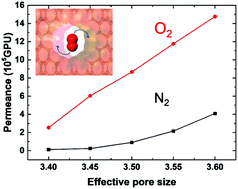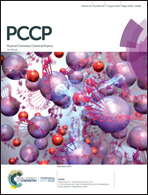Entropic selectivity in air separation via a bilayer nanoporous graphene membrane†
Abstract
Membranes represent an energy-efficient technology for air separation, but it is difficult to control the pore size to separate N2 and O2 due to their similar kinetic diameters. Here we demonstrate by molecular dynamics simulations that a bilayer nanoporous graphene membrane with continuously tunable pore sizes by the offset between the two graphene layers can achieve O2/N2 selectivity of up to 26 with a permeance of over 105 GPU (gas permeation unit). We find that entropic selectivity is the main reason behind the high selectivity via the tumbling movement of the skinnier and shorter O2 molecules entering and passing through the elliptic-cylinder-shaped nanopores of the bilayer membrane. Such motion is absent in the single-layer graphene membrane with pores of similar size and shape which yields an O2/N2 selectivity of only 6 via molecular sieving alone. Hence the bilayer nanoporous graphene membrane provides a novel way to enhance the entropic selectivity for gas separation by controlling both the pore size and the 3D pore shape.



 Please wait while we load your content...
Please wait while we load your content...